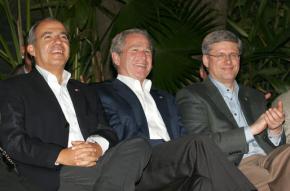Brewing crisis for Canada’s Conservatives
reports on the rising opposition to the Harper government in Canada and the prospects for struggle ahead.
FACED WITH a possible vote of "no confidence" that would have forced a shake-up in the Canadian government, right-wing Prime Minister Stephen Harper convinced the governor general to suspend the country's parliament--for close to two months.
Without this maneuver--an undemocratic relic of Canada remaining part of the British Commonwealth, which gives the governor general special powers as the "queen's representative"--Harper's Conservative Party government very likely would have fallen and been replaced by a coalition government of the Liberals (similar to the Democrats in the U.S.) and the New Democratic Party (Canada's labor party, the NDP).
The political crisis has brought large numbers of people into action. Both the Liberal-NDP coalition and Harper's Conservatives have mobilized rallies across the country. The Canadian labor movement is squarely on the side of the Liberal-NDP coalition.
One prominent part of the debate is the issue of sovereignty for the oppressed nation of Quebec. The coalition could only form a government if it was supported by the Parti Quebecois, which has traditionally called for independence for the predominantly French-speaking Quebec.

Harper has resorted to Quebec-bashing to maintain backing for the Conservative Party government. "They propose a new coalition, which includes the party in parliament whose avowed goal is to break up the country," Harper said earlier this month. "This is no time for back room deals with the separatists."
But the wider background to the suspension of parliament is the economic crisis.
In November, Canada lost 71,000 jobs (the equivalent, when total population is taken into account, of more than 700,000 jobs in the U.S.), according to the government. This was the biggest job loss in 26 years.
Rather than propose any measures to help working people suffering through the downturn, the Conservatives continued to press their pro-business agenda. At the end of November, Harper's Finance Minister Jim Flaherty introduced a new set of proposals, including restrictions on wages for public workers and a ban on their right to strike through 2011.
But the final straw for the Liberals and NDP was Flaherty's call to cut public financing for political parties--which would have given an advantage to Conservatives, with their access to big business money.
IN ELECTIONS in October, none of the major parties inspired confidence, and turnout was only 59 percent, the lowest in Canadian history and a stark contrast to the U.S. vote a month later.
But the Conservatives added slightly to their seats in parliament and remained the ruling party. Though still a minority, Harper expected to govern with increased strength. Instead, the economic crisis and other factors have given momentum to the opposition and pushed his government to the edge.
What happens next is in doubt. Will the Harper government be able to win a majority in parliament for its budget proposal? If not, will the Liberal-NDP coalition be stable enough to form a government? What policies will either government pursue in the face of the continued crisis?
These questions will be answered in large part by the response of the labor movement and other social struggles. The mobilizations across the country in recent weeks and even the concessions won from the Conservatives during the election campaign before the October vote are exciting signs of a shift in Canadian politics.
But it will take a further fight to win real changes. That's especially true given the experience of the opposition parties when they held office.
The Liberals came to power in 1993, defeating the unpopular Conservatives. By 1995, they had enacted the largest social spending cuts in Canadian history. They implemented the North American Free Trade Agreement, a cornerstone of the neoliberal attack on workers, and later sent troops to Afghanistan on the crest of a major military buildup.
The NDP has roots in the labor movement and a more left-wing record than the Liberals. However, when in control of provincial governments, it, too, has implemented social spending cuts.
The NDP's current coalition with the Liberals is based on fiscal conservatism. Its accord with the Liberals ties the NDP to a program that includes a $50 billion tax break for banks and a $30 billion economic stimulus that would primarily benefit corporations. In reality, the accord with the NDP gives the Liberals a left cover to appeal for support.
Most of the labor movement supports the Liberal-NDP coalition as an advance over the Conservatives. But if this means limiting the demands and actions of unions and social movements to make sure the coalition wins, it will be an opportunity lost.
The economic crisis in Canada has caused immense suffering, as it has around the world. However, it has also created a political crisis that opens up exciting possibilities for militant struggle.


